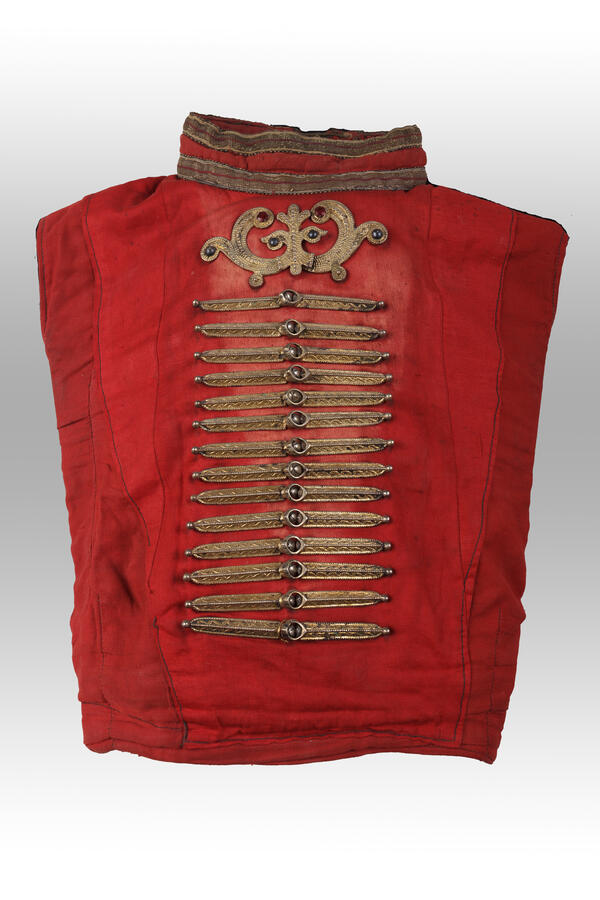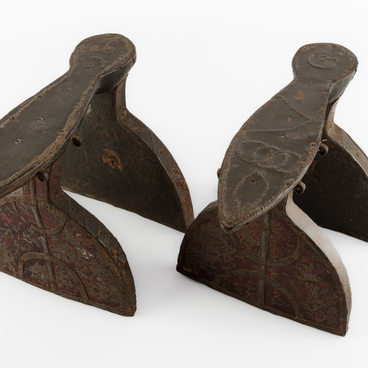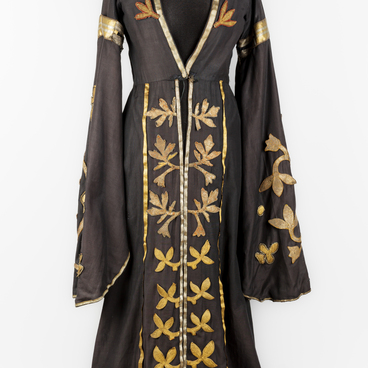A false shirtfront is an integral part of the Circassian costume. Initially, a short caftan was worn over a long shirt, and a dress with long false sleeves (sai) was put on top. The caftan was sewn from velvet and decorated with gold and silver embroidery. A little later, by the late 19th century, an imitation of a caftan became widespread — it was a small rectangular shirtfront, which often had a standing collar. Like the caftan, this clothing item had from 14 to 16 pairs of fasteners with cast metal loops. However, unlike the caftan, which could be fastened only with strong tension, so it would fit snugly to the body, the shirtfront clasps had a decorative function and were connected with hooks.
At the beginning of the 20th century, shirtfronts began to be sewn from any dense fabric that the family could afford. Only wealthy or noble families still had their shirtfronts decorated with gold and silver embroidery, as well as precious and semiprecious stones. Still, a shirtfront was a more affordable variation of a caftan, since it needed less expensive material.
The museum exhibition includes a shirtfront of the early 20th century. It was made of dense red cloth and has a standing collar and 14 pairs of false bronze clasps with cast loops descending from the collar to the belt. The shirtfront was fastened around the neck with hooks, and at the waist it was girdled with a thin belt. The collar is decorated with galloon — a dense woven braid. Galloons were woven both in Europe and in the Caucasus, where this technique was widely used among the Circassian tribes.
Looms were made of quadrangular thin wooden boards measuring from 6 to 8 cm. Depending on the complexity of the pattern, the number of boards could vary from 15 to 120 pieces. Four to six holes were drilled in the corners of each plank. Craftswomen pulled threads of several colors through these holes to get the desired pattern. The beauty of these patterns depended on the complexity of thread patterns. After each stage, the fragment of the pattern was fixed with a thread on a wooden slider. The finished part of the galloon was wound on a metal hook attached to the belt of the craftswoman. Galloons not only decorated Circassian festive costumes, but were also used to hide side seams made by hand. At the neck of the shirtfront there is a massive bronze decoration inlaid with colored glass. It is made using the granulation technique — an ornament in the form of tiny spheres of different diameters, which were soldered onto jewelry.
At the beginning of the 20th century, shirtfronts began to be sewn from any dense fabric that the family could afford. Only wealthy or noble families still had their shirtfronts decorated with gold and silver embroidery, as well as precious and semiprecious stones. Still, a shirtfront was a more affordable variation of a caftan, since it needed less expensive material.
The museum exhibition includes a shirtfront of the early 20th century. It was made of dense red cloth and has a standing collar and 14 pairs of false bronze clasps with cast loops descending from the collar to the belt. The shirtfront was fastened around the neck with hooks, and at the waist it was girdled with a thin belt. The collar is decorated with galloon — a dense woven braid. Galloons were woven both in Europe and in the Caucasus, where this technique was widely used among the Circassian tribes.
Looms were made of quadrangular thin wooden boards measuring from 6 to 8 cm. Depending on the complexity of the pattern, the number of boards could vary from 15 to 120 pieces. Four to six holes were drilled in the corners of each plank. Craftswomen pulled threads of several colors through these holes to get the desired pattern. The beauty of these patterns depended on the complexity of thread patterns. After each stage, the fragment of the pattern was fixed with a thread on a wooden slider. The finished part of the galloon was wound on a metal hook attached to the belt of the craftswoman. Galloons not only decorated Circassian festive costumes, but were also used to hide side seams made by hand. At the neck of the shirtfront there is a massive bronze decoration inlaid with colored glass. It is made using the granulation technique — an ornament in the form of tiny spheres of different diameters, which were soldered onto jewelry.



